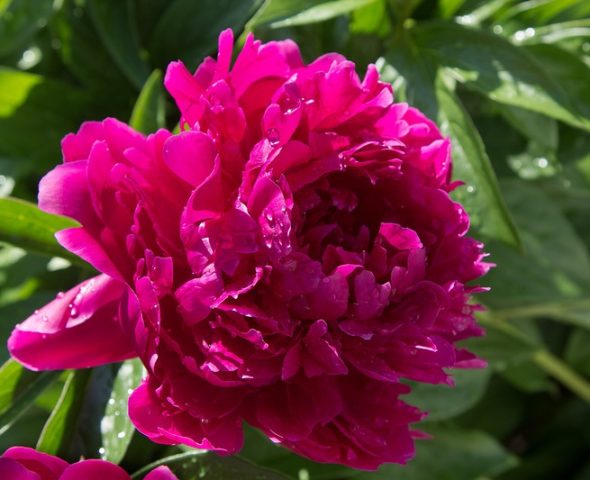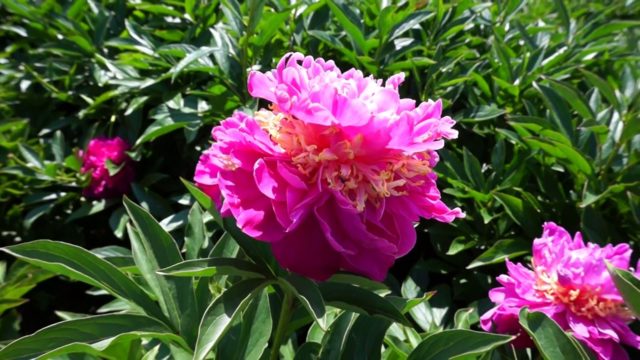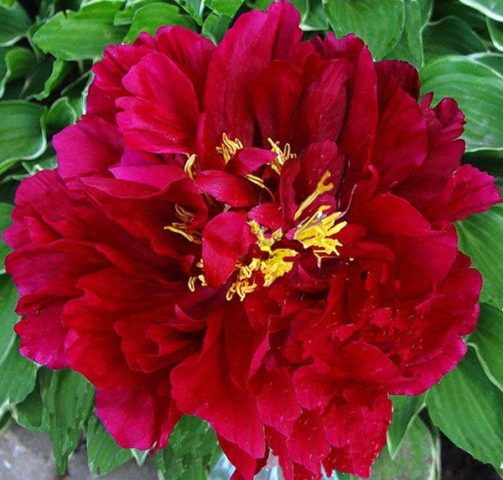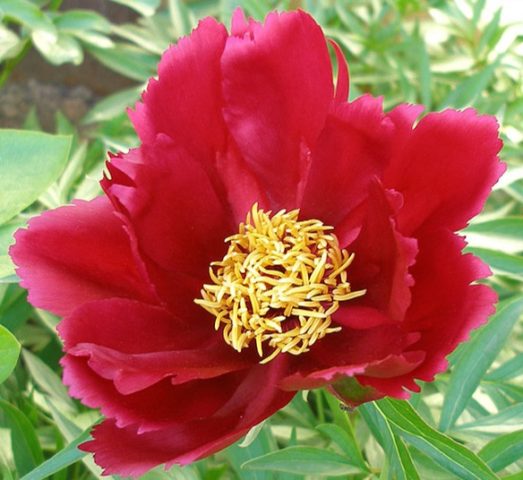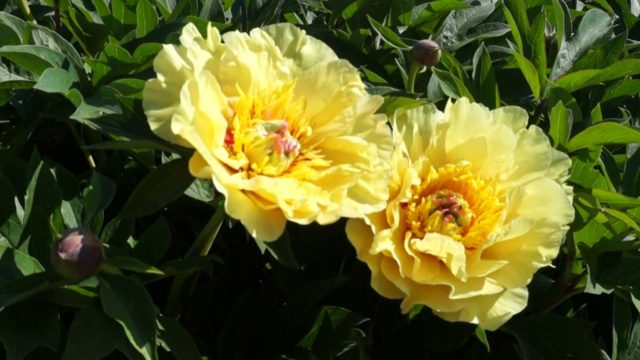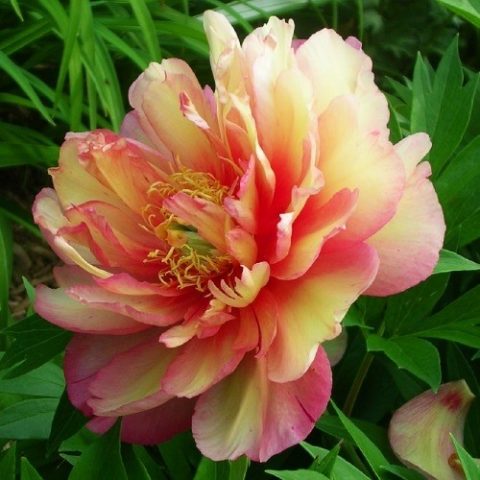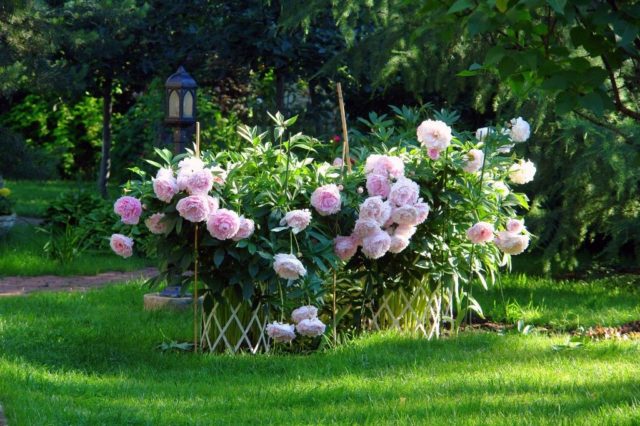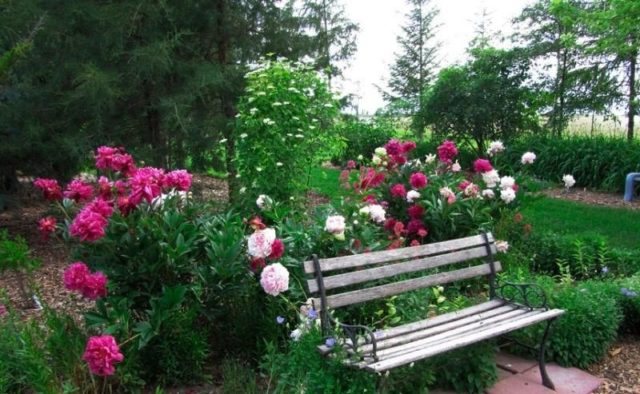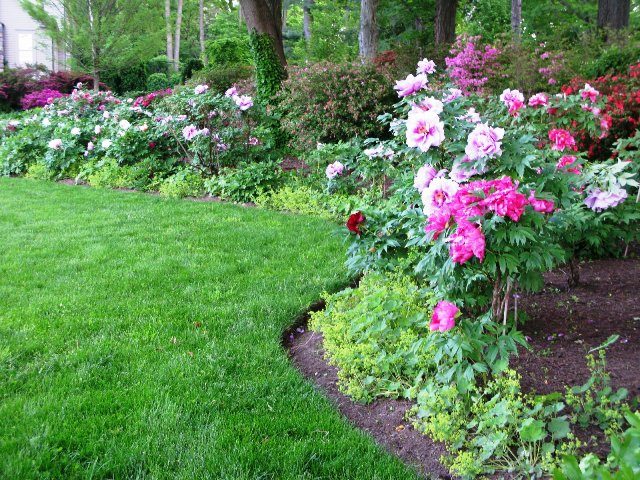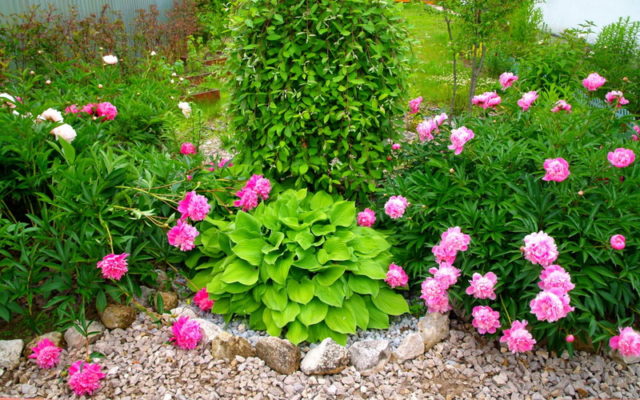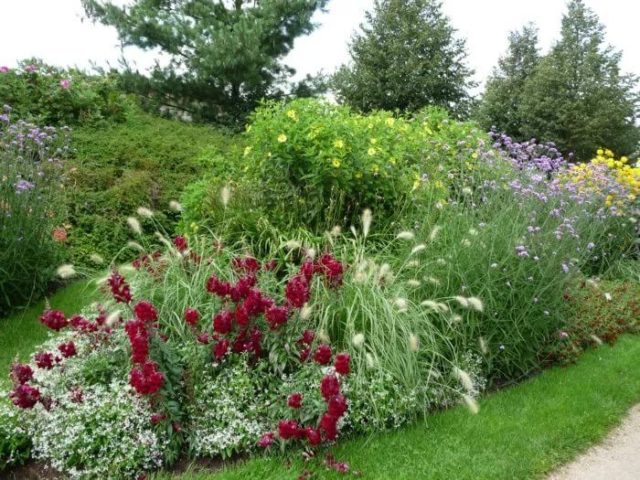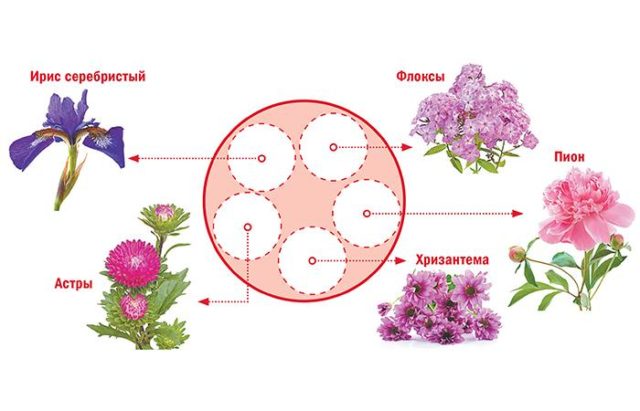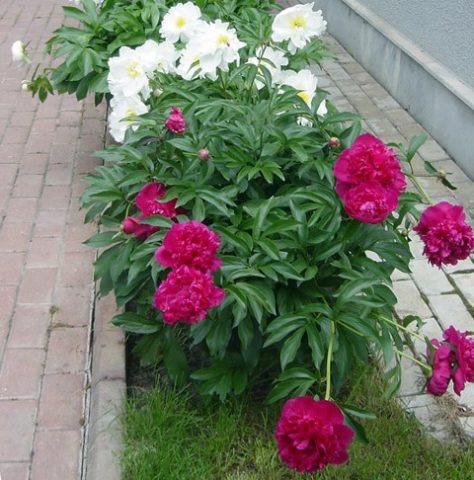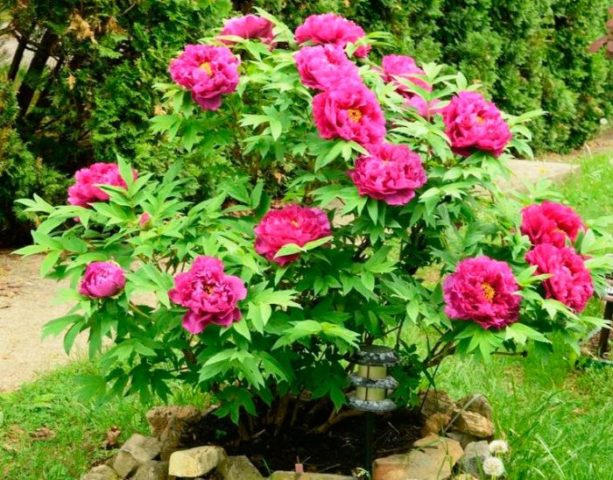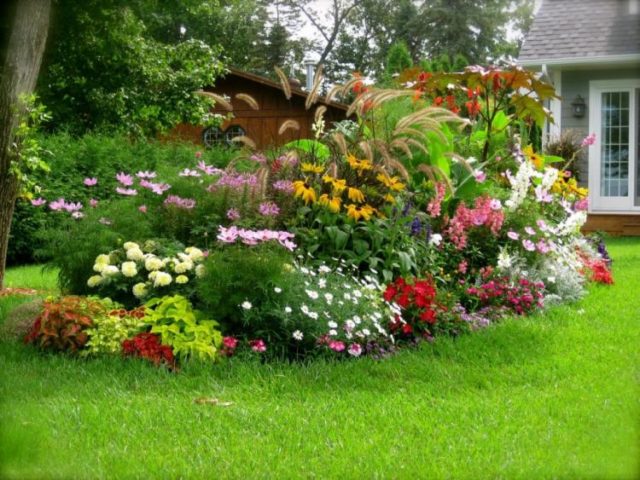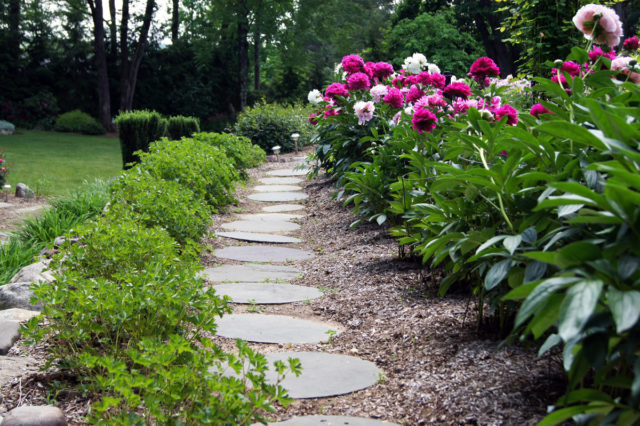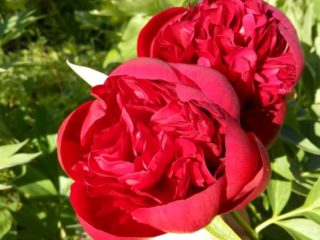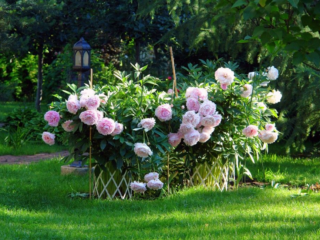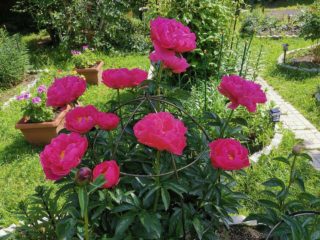Content
- 1 Features of the use of peonies in the landscape design of a garden or site
- 2 What can be planted next to peonies
- 2.1 What ornamental plants can be planted next to peonies
- 2.2 What flowers can be planted next to peonies
- 2.3 Is it possible to plant peonies next to trees
- 2.4 Compatibility of peonies and thuja in landscape design
- 2.5 Compatibility of irises and peonies in landscape design
- 2.6 What should not be planted next to peonies
- 3 How to arrange flower beds with peonies
- 4 A few ideas on how to beautifully plant peonies
- 5 Design Tips
- 6 Conclusion
Peonies are widely used in landscape design, as they are beautiful and at the same time undemanding perennial plants. Large bushes are usually planted separately - mainly in open spaces. And shorter ones are used in compositions with other plants, picking them up by color and height.
Features of the use of peonies in the landscape design of a garden or site
For a thoughtful design of a flower bed with peonies, it is recommended to use the decorative properties of this plant to the maximum. Peonies are prized not only for their bright and lush flowers, but also for the shape of the bush, leaves and the shade of the petioles (in some they are bright red). Therefore, the gardener first needs to select several varieties, focusing on color, height, stem strength and flowering time.
How to choose varieties of peonies for decorating a garden or plot
When choosing varieties of peonies, first of all, they pay attention to the shades, shape and size of flowers. Also, peonies in the landscape should have fairly strong stems so that they can reliably hold even a large number of flowers.
Therefore, to decorate the garden, you can recommend the following varieties:
- White sands - white with yellow stamens;
- My love - white and pale pink;
- Karl rosenfield - fuchsia shade;
- Feather top - also a fuchsia shade, with lilac tones;
- Old faithful - red;
- John Howard Wiegell and Kevin - pale pink.
It is also worth considering the timing of flowering. For example, among the early flowering varieties, the following are especially attractive:
- Dutch dwarf - pink, Japanese form;
- Tiny Tim - a miniature bush in the shape of a hat;
- Merry mayshine - a bush with graceful narrow leaves;
- Fairy Princess - large buds, rich pink hue;
- Eaglet - a variety with an interesting decorative bush in the form of a vase and small but very bright flowers.
Recently, Ito hybrids are often used in landscape design: these are peonies obtained from crossing tree and herbaceous varieties:
- Garden treasure - light yellow, rather large;
- Bartzella - terry, yellow;
- Viking full moon - light yellow with an orange core;
- Julia rose - pink, light yellow, cream shade, grows as a compact bush.
Garden decoration with peonies
Peonies are very bright, often large flowers that grow on lush, compact or spreading bushes. They serve as a full-fledged decoration of the garden, therefore they can be used both in independent plantings and in compositions.
Here are some photos of the design of the site with peonies in the garden:
- Planting in rows along a path is a great way to decorate a path, and also separate one area of the garden from another.
- A hedge of peonies is one of the classic techniques in landscape design. It looks especially good against the background of a well-groomed lawn - bright flowers are in harmony with a green tint.
- Single planting against the background of bushes of about the same height.
- Central flowerbed on an open lawn.
- Planting peonies next to a bench, gazebo and other recreation areas is often used for decoration in landscape design.
Design of a plot with peonies
To decorate the site, flower growers strive to follow the classic design rules, that is, to correctly combine color shades, sizes and shapes of the bushes. Since many peonies are distinguished by attractive flowers, they can be safely used in the landscape design of any flower garden and garden, for example:
- Classic flower beds of a round shape.
- A zigzag row of peonies is used in landscaping for garden zoning.
- A kind of hedge of different varieties of flowers.
- Flowers combined with perennial shrubs.
- Also in landscape design, rocky flower beds are often used, on which these flowering shrubs also look appropriate.
What can be planted next to peonies
You can plant both flowers and perennial green plants - herbaceous, conifers and other crops next to peonies in a flowerbed, in a hedge or along paths. It is important to choose them so that they are harmoniously combined both in color and in height.
What ornamental plants can be planted next to peonies
Peonies go well with decorative perennials:
- With different types of host, against which the lush flowers will look especially beautiful.
- With various conifers (thuja, dwarf spruces) - they look especially beautiful on rocky flower beds, in rock gardens and on the coast of water bodies.
- With herbaceous perennials that can be used in carpet plantings to decorate empty spaces in the garden.
Peonies harmonize very well with the hosts, creating a pleasant partial shade for them.
What flowers can be planted next to peonies
These plants are in good harmony with many flowers, for example:
- chrysanthemum;
- daylily yellow;
- delphinium;
- honeysuckle;
- astilba;
- daisy;
- tulip;
- poppies.
Is it possible to plant peonies next to trees
Planting peonies next to tall, lush and spreading trees is not a good idea, as they provide shade for much of the day. These are, for example, apple, maple, pine and others. And even if a large tree does not shade the area (for example, a compact spruce), it will take up a significant part of water and nutrients, which will have a negative effect on the development of the main crop.
Compatibility of peonies and thuja in landscape design
Thuja fits perfectly into almost any flower garden due to its beautiful greenery and graceful shape. Therefore, it is also used in planting with peonies, especially with pink, bright yellow and red.
Compatibility of irises and peonies in landscape design
Irises are especially beautifully accentuated by white peonies. Both crops prefer bright sunlight, so it is appropriate to place them on an open lawn.
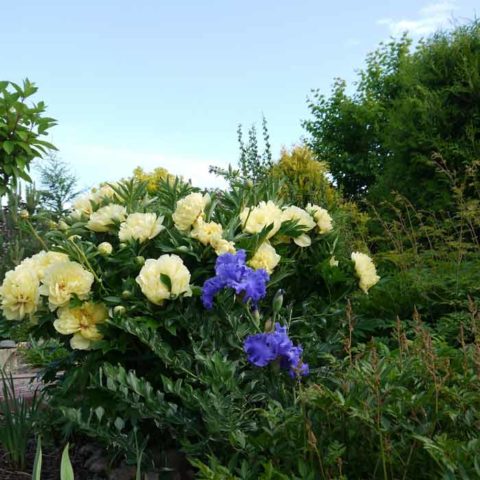
The combination of light yellow and blue shades is one of the most harmonious
What should not be planted next to peonies
It is not recommended to plant next to these flowers:
- Lush shrubs providing strong shade.
- Garden trees - they not only provide shade, but also take away moisture and nutrients.
- Any plants from the Buttercup family - they actively fill the site and compete with the main crop, sometimes inhibiting its development.
- Small flowers (pansies, petunias, marigolds), which look bad in landscape design against the background of peonies, since they disappear from the general background.
How to arrange flower beds with peonies
To decorate a flower bed beautifully, it is important to consider:
- combination of colors (contrast of red against green, blue with yellow, bright with darker);
- tiered - large in the center, smaller - in the foreground;
- general shape - for example, a circle can be visually distinguished using low flowers or perennials (hosts, blue fescue, wild oats).
Rules for decorating flower beds with peonies
If made up of different varieties, it is best to plant them at the same time so that they grow in sync. In addition, they should roughly coincide in height and bloom at the same time, otherwise the desired effect will not work. Color combinations can be different - for example, red and white, yellow and red, pink and white.
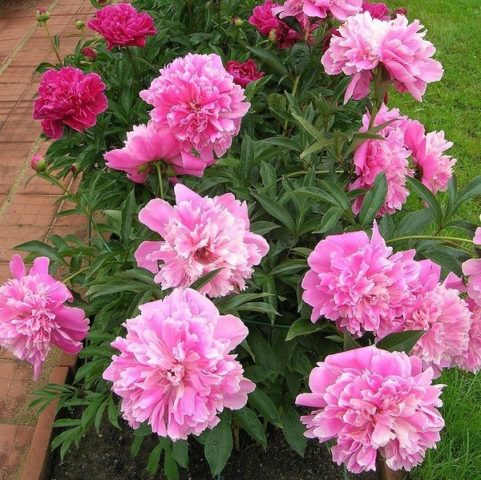
It is better to pick up bushes of the same height or plant high ones in the center, and low ones at the edges.
Mixed flower beds with peonies in landscape design
These plants can be combined with different colors, taking into account the color range and their height. They are planted in mixborders, hedges along the road, in various compositions (rock gardens, on the coast, rocky flower beds).
Mixborders decorate a flower garden well, therefore they are very often used in landscape design.
Examples of schemes of flower beds and flower beds with peonies
When creating a flower bed, you can take the proven schemes shown below as a basis.
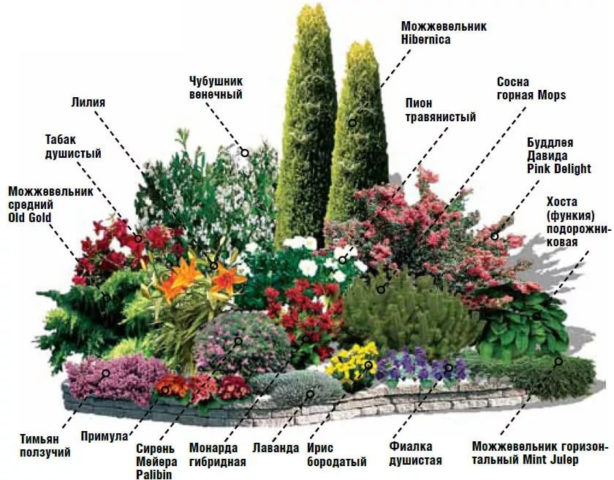
The correct location will allow you to achieve alternate lush flowering

1-delphinium, 2-peonies, 3-any lilac flowers, for example, catnip, 4-azorella three-forked
Another option is to make a round flower bed of perennial flowering plants:
- iris silvery;
- phlox;
- peonies (pink and lilac varieties are better suited here);
- chrysanthemum;
- asters.
A few ideas on how to beautifully plant peonies
And a few more ideas for using these bright shrubs in landscape design with photos for inspiration:
- Multi-tiered flower beds.
- Rabatki along the house. In design, they are used for zoning and forming the visual boundaries of the entire flower garden.
- In single landings. This technique is used in landscape design when you need to highlight the center of the garden or just close empty, ugly places.
- In the flower beds.
Design Tips
Each garden has its own characteristics, and truly beautiful flower arrangements can be made taking into account the advice of professional designers. Therefore, it is recommended to pay attention to some landscape tricks, thanks to which the peonies in the garden will look really impressive:
- The brightest, most luxurious flowers are used in single plantings in the center of the garden.
- When creating multi-tiered compositions, smaller plants are planted in the foreground, and the highest ones in the background.
- When choosing plants for a flower bed, color combinations are taken into account: for example, light yellow peonies look good against a background of yellow-green grass.
- The bright flowers look good against the lush green backdrop of the lawn. If the bush is quite tall, it is better to form it on a trunk, that is, to give the shape of a tree, removing all the lower shoots.
- Along the edges of the path and in the hedge, it is advisable to use peonies of approximately the same height, as well as the same flowering period. It is optimal to plant them in one year so that they grow synchronously.
Conclusion
Peonies are widely used in landscape design. And this is due not only to their natural beauty, but also to their practicality. Many varieties (including exotic, not yet widespread) are distinguished by high winter hardiness and undemanding care. This allows them to be cultivated in almost any region of Russia - both in the Central part and in the Urals, Siberia and the Far East.


